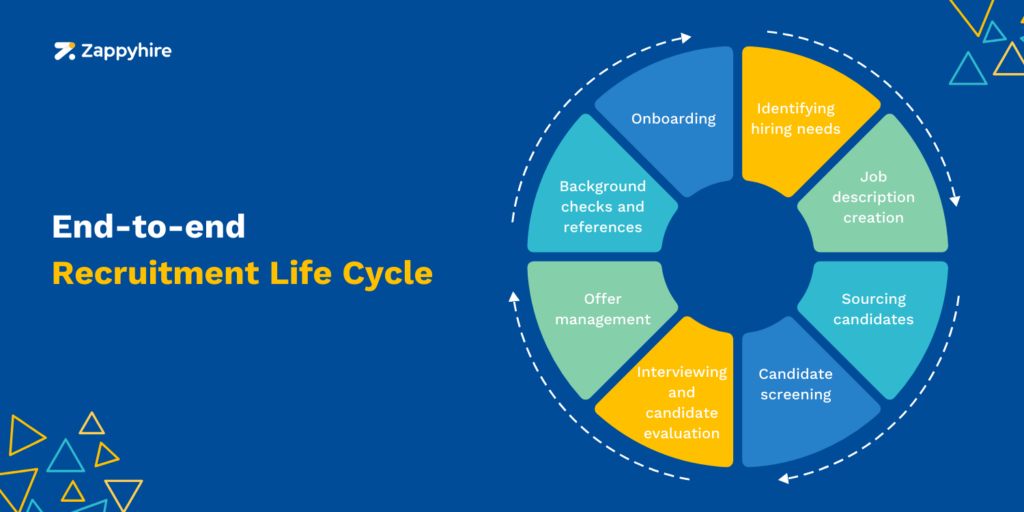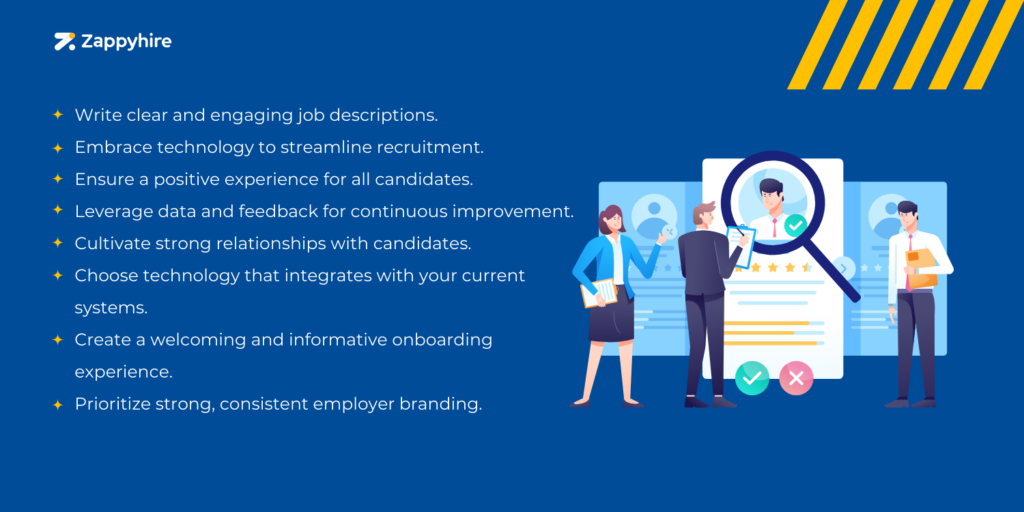
Every hiring journey begins with a single step – job requisition. But the steps that follow are just as crucial.
The importance of end-to-end recruitment cannot be overstated in modern HR practices.
It not only streamlines the recruitment process, making it faster and more efficient but also improves the quality of hires by maintaining a consistent candidate experience and evaluation standards throughout.
What is an end-to-end recruitment process?
Think of the end-to-end recruitment process as the complete journey of hiring someone, from the moment a company realizes it needs someone new to the point where that new hire starts working.
It’s an all-inclusive approach to finding, hiring, and welcoming new employees into the company.

What does an end-to-end recruitment life cycle look like?
Each of these steps is crucial for making sure that the right person gets the job and that they’re ready to hit the ground running! Now, let’s break down the steps:
1. Identifying hiring needs
This is where the company figures out they need someone new. Maybe someone has left, or there’s just more work than the current team can handle.
2. Job description creation
Now it’s time to describe what that new person will do, creating a job description that outlines the responsibilities and necessary skills.
Creating a job description that is fair and accurate is crucial, as it ensures that all candidates are evaluated against the same standards and helps attract the right talent that truly fits the role.
3. Sourcing candidates
With the job description in hand, the hunt for candidates begins, targeting not just active but also passive candidates.
This could involve posting the job online, reaching out through networks, or even scouting for talent at events.
Pro tip – Platforms that integrate seamlessly with multiple job boards streamline this process, significantly expanding reach and improving the chances of finding the perfect match.
4. Candidate screening
As resumes and applications start rolling in, they need to be reviewed to find the most promising candidates.
This often involves looking at their skills, experience, and potentially preliminary tests or tasks.
Recommended Article
Top 10 Resume Parsing Software in 2024
5. Interviewing and candidate evaluation
The top candidates go through interviews. This step helps the company get to know the candidates better and see if they’re a good fit for both the job and the company culture.
Evaluations during the interview and candidate evaluation stage are enhanced through a blend of video interviews and versatile assessment platforms.
Video interviewing software facilitates face-to-face interactions remotely, allowing assessors to gauge communication skills and cultural fit without geographical constraints.
Additionally, comprehensive assessment platforms offer a variety of testing formats, including multiple-choice, essays, and specialized technical assessments.
These tools enable a thorough evaluation of candidates’ knowledge, problem-solving abilities, and job-specific skills, ensuring a holistic view of each candidate’s capabilities and fit for the role.
6. Offer management
Once a candidate stands out, they get an offer. This part includes negotiating the terms of employment and making sure both sides are happy with the agreement.
In the offer management stage, platforms like Zappyhire streamline the process by allowing recruiters to create, customize, and send offer letters directly within the system.
This automation ensures efficient negotiations and agreement finalization, enhancing satisfaction for both employers and candidates.
7. Background checks and references
Before the deal is sealed, the company conducts a thorough background verification to ensure everything the candidate has said is true and they’re genuinely a good fit.
Many organizations opt for specialized tools available in the market to carry out these checks efficiently. Comprehensive Applicant Tracking Systems (ATS) like Zappyhire seamlessly integrate with these tools.
This ensures recruiters implement a complete end-to-end recruitment process within a single system, thereby ensuring reliability and integrity in hiring decisions.
8. Onboarding
The new employee starts their job, and the company helps them get up to speed on everything they need to know to be successful in their new role.
What challenges are commonly faced during end-to-end recruitment?
Although a comprehensive end-to-end recruitment cycle is advised and valuable, putting it into practice can present its own challenges.
1. Identifying quality candidates in a large applicant pool
Sifting through a large number of applicants to find the right candidate is akin to finding a needle in a haystack.
It involves meticulously analyzing each application to distinguish standout individuals who not only meet the required qualifications but also align with the company’s culture and values.
This process is crucial for ensuring that the talent acquisition efforts are targeted and effective.
What can be done
Leveraging advanced applicant tracking systems (ATS) and AI-driven screening tools can help prioritize candidates based on skills and experience, making it easier to spot the right talent and making way for data-driven recruitment.
Recommended Article
Top 9 High Volume Hiring Strategies For Faster And Better Hires
2. Ensuring a fair and unbiased recruitment process
Making sure every candidate gets a fair shot and that biases (conscious or unconscious) don’t sneak into decisions is a big challenge, which is why focusing on diversity, equity, and inclusion (DEI) is crucial.
Companies in the top quartile for women representation on executive teams are 18% more likely to outperform financially compared to their competitors.
Additionally, those with highly diverse teams see a substantial increase in cash flow – up to 2.5 times per employee.
According to a CNBC survey, 80% of respondents prefer to work for companies that prioritize DEI efforts.
What can be done
Implementing structured interviews and using software that automatically extracts candidate details and ranks them according to their skills and expertise in an accurate way. This can help reduce biases in the hiring process.
3. Streamlining communication between various stakeholders
From hiring managers to HR to interviewers, everyone needs to be on the same page, and keeping communication clear can be tricky.
What can be done
Using centralized communication platforms that can be integrated easily with your current recruitment system and regular update meetings can ensure everyone stays informed and aligned.
4. Managing logistical issues in scheduling and feedback collection
Organizing interviews and gathering feedback afterwards can be like herding cats, especially when dealing with busy schedules.
What can be done
Automated interview scheduling tools and feedback systems can streamline these processes, ensuring timely and organized coordination.
Recommended Article
Applicant Tracking System Software – Every HR’s Go-To Guide
5. Integrating technology with human processes
Balancing tech tools with the human touch of recruitment ensures efficiency without losing the personal element that attracts top talent.
What can be done
Choose technology that enhances human interaction, like video interviewing tools and candidate relationship management systems, to maintain personal engagement without sacrificing efficiency.
6. Enhancing candidate experience
Ensuring every candidate has a positive experience, regardless of the outcome, can really set a company apart.
76% of candidates cited a positive experience as a key factor in their decision to accept a job offer
What can be done
Regular communication, transparent processes, and constructive feedback can enhance the candidate’s journey and leave a lasting positive impression.
7. Budget constraints while competing for top talent
Finding amazing people without breaking the bank is always a balancing act.
What can be done
Focus on building a strong employer brand using recruitment marketing and offering non-monetary benefits like flexible working conditions to attract candidates.
Recommended Article
What is People Analytics and How Can it Help in Hiring Top Talent?
8. Adapting strategies for remote hiring and virtual onboarding processes
In a world where remote work is common, figuring out how to effectively hire and onboard from afar adds an extra layer of complexity.
What can be done
Invest in online interviewing software and develop remote onboarding programs that help new hires integrate into the company culture from afar.
What are end-to-end recruitment roles and responsibilities?
End-to-end recruitment involves several key roles, each with specific responsibilities that contribute to the overall effectiveness of the hiring process.
The importance of collaboration and communication among these roles cannot be overstated. While their tasks might overlap – like recruiters and hiring managers both engaging with candidates – their unified effort is what leads to successful hires.
Here’s an outline of these roles and their associated responsibilities:
1. Recruiters
Role
They are the front-line operators in the recruitment process, tasked with discovering and attracting candidates, assessing their fit for roles, and maintaining candidate engagement
Responsibilities
- Utilize various sourcing strategies including job boards, social media, and networking events to find potential candidates.
- Conduct initial screening of resumes and applications to identify suitable candidates based on job requirements.
- Arrange and conduct initial interviews to assess candidates’ qualifications and fit for the role.
- Maintain communication with candidates throughout the recruitment process to keep them informed and engaged.
- Liaise with hiring managers and HR coordinators to ensure smooth progression of the recruitment process.
2. Hiring Managers
Role
Their primary role is to define the needs of the position and select the ideal candidate to fill the job, contributing to interviews and the subsequent onboarding of new hires.
Responsibilities
- Collaborate with HR to define precise job descriptions and candidate specifications.
- Participate in the interview process, especially in later stages, to evaluate candidates’ technical skills and team fit.
- Make the final hiring decision based on interviews and assessments.
- Assist in the onboarding process to ensure new hires integrate effectively into their teams.
3. HR Coordinators
Role
They handle the logistical and administrative aspects of recruitment, from scheduling interviews to ensuring compliance and smooth onboarding.
(Note – These roles are often fulfilled by recruiters, especially in smaller or more streamlined organizations. However, in larger organizations or those with a dedicated HR department, these tasks are typically handled by HR coordinators)
Responsibilities
- Schedule interviews, reserve meeting spaces, and ensure all necessary equipment and materials are available for interviews.
- Manage all administrative documentation related to candidates’ applications, interviews, and hiring statuses.
- Ensure all recruitment activities comply with company policies and legal regulations.
- Coordinate onboarding logistics, including orientation schedules and introductory training sessions.
4. HR Managers
Role
Responsible for shaping and guiding the recruitment strategy, policy formulation, budgeting, and overall performance evaluation of the recruitment process.
Responsibilities
- Develop and oversee the recruitment strategy aligned with the organization’s goals.
- Create and refine recruitment policies and procedures to improve efficiency and compliance.
- Manage the recruitment budget and negotiate contracts with external vendors and agencies.
- Track recruitment metrics to evaluate the effectiveness of recruitment strategies and implement improvements.
5. Talent Acquisition Specialists
Role
Specialists in promoting the company’s image as a desirable employer and utilizing sophisticated sourcing and technology tools to attract top-tier talent.
Responsibilities
- Develop and promote the employer brand to attract top talent.
- Implement advanced sourcing techniques to reach passive candidates and reduce dependency on active job seekers.
- Leverage recruitment technologies such as Applicant Tracking Systems (ATS) and AI-powered tools to enhance recruitment processes.
The role of technology in end-to-end recruitment

AI-powered recruitment platforms are at the heart of modern recruitment strategies. They’re equipped with various capabilities that automate and enhance different stages of the hiring process.
| 📈 91% of recruiting professionals using Generative AI tools report that it makes writing job descriptions faster and easier. |
For example, resume parsing tools can quickly sift through hundreds or even thousands of resumes to identify the most promising candidates based on predetermined criteria such as skills, experience, and education.
These platforms can assess a candidate’s suitability through automated online assessments and simulations that evaluate their skills and competencies in a fair and standardized manner.
They provide tools/portals that help different stakeholders (like recruiters, hiring managers, and interviewers) to have seamless collaboration while hiring.
Technology in recruitment truly shines when it seamlessly integrates with an array of tools and services, making the hiring process more efficient and interconnected.
By connecting with various job boards, the recruitment system casts a wider net, attracting a diverse pool of candidates.
They can also integrate with third-party providers that conduct background checks, verifying candidate information quickly and efficiently.
Once a candidate becomes a part of your team, the real magic of integration comes into play. Onboarding tools connected to your recruitment system can kickstart a new hire’s journey without a hitch.
This creates a welcoming and engaging experience for new hires, helping them settle in comfortably and quickly.
These tools help in smoothing out the whole candidate journey. This is quite important because,
- 83% of talent say a negative interview experience can change their mind about a role or company they once liked.
- 87% of talent say a positive interview experience can change their mind about a role or company they once doubted.
Best practices for a smooth end-to-end recruitment

Effective job descriptions to attract the right candidates
Think of a job description as the first conversation with your potential employee, so make it clear and inviting. Detail what the job entails and the skills you’re seeking.
This clarity helps attract those who are a perfect fit, reducing time spent on unsuitable candidates.

Utilize technology for efficient processes
Technology isn’t just about gadgets – it’s about making your recruitment process smarter and smoother.
From tracking applications to scheduling interviews, the right tools can save you time and trouble, allowing you to focus on personal interactions.
In fact, 75% of recruiters use an ATS or another recruiting tool to review applicants and strengthen the overall candidate experience.
Plus, 94% of recruiters state that their ATS has had a positive impact on their company’s hiring processes.
Maintain a positive candidate experience
Every candidate interaction shapes your company’s reputation. Keep candidates informed, respect their time, and provide feedback.
A positive candidate experience can turn even rejected applicants into advocates for your brand.
Continuous improvement through feedback loops and data analysis
Use feedback loops and data analysis not just as tools, but as teachers. They help you understand what works and what doesn’t in your hiring process, leading to better strategies and happier candidates.
Develop strong candidate relationships
Building relationships means seeing beyond the immediate hire. Engage with candidates genuinely, keep in touch, and think of them for future opportunities.
This long-term view can turn today’s interviewee into tomorrow’s star employee.
Invest in technology that can be integrated with existing systems
Your recruitment tech should fit into your existing systems like a puzzle piece. It should enhance your process, not complicate it.
| 💡 Quick Fact – Zappyhire integrates with leading job boards, calendars, background check services, and more, ensuring a flawless fit into your existing recruitment ecosystem! |
Create a great onboarding experience
Once they join, make sure new hires feel welcome and well-prepared to start their journey at your company.
Automated workflows, digital document management, and virtual training sessions can help new hires hit the ground running with less hassle.
Make robust employer branding a priority
Make use of recruitment marketing to develop a strong employer brand that reflects your company’s values and culture.
This attracts top talent and helps retain them by aligning expectations from the outset.
Conclusion – Embracing the full spectrum of recruitment activities
From identifying needs and sourcing candidates to onboarding and integration – with this, you’ll be better equipped to attract and retain the top talent necessary for enduring success.
Leveraging sophisticated technologies like AI-powered applicant tracking systems, aka recruitment automation platforms not only simplifies this complex process but also enriches the candidate experience and ensures a fair, unbiased selection process.
As the workforce continues to evolve, the integration of such technologies with human insights will remain critical, ensuring that recruitment strategies are not only efficient but also deeply human-centric.





